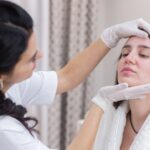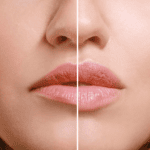
How long do the results of a non-surgical facelift last?
21/02/2024
Liplase®: The Future of Lip Enhancement Without Lip Injection
09/09/2024
Age spots are sometimes also called sunspots or liver spots. These flat, darkened areas of skin can appear on the face, chest, hands, shoulders, and other sun-exposed areas. While harmless, they can be a bothersome concern for many and can affect an individual’s confidence.
Here, we discuss how laser therapy can be a safe and effective solution for reducing the appearance of age spots and achieving a clearer, more even complexion.
Let’s get started!!
Root Cause of Age Spots
You will know that overexposure to the sun harms your skin. Let’s understand the science behind it.
To understand the sun’s role in age spots, you need to understand what melanin is and what it actually does in our bodies.
So, melanin is the pigment responsible for your skin’s colour or tone. When your skin is exposed to ultraviolet (UV) rays from the sun, melanin production increases in an attempt to shield the deeper layers from sun damage. This is why your skin tans after exposure to the sun.
Over time, with repeated sun exposure, melanin production can become uneven. Clumps of Melanin can form in the skin cells, leading to the appearance of darker areas—these are your age/sun spots.
Is the Sun Only Responsible for This?
While sun exposure is the first culprit, other factors can also contribute to uneven melanin distribution.
- Blue light from Laptops and screens have also been shown to cause skin damage.
- As we age, our skin’s natural ability to repair itself from sun damage diminishes, making age spots more likely.
- Fluctuations in hormones, particularly during pregnancy or menopause, can also influence melanin production.
- Some people are simply more predisposed to developing age spots due to their genetic makeup.
Treatment Options for Age/Sun Spots
- Topical Creams: Over-the-counter and prescription creams are widely used to lighten age spots. These might contain hydroquinone, glycolic acid, kojic acid, or retinoids. Regular application can gradually fade the spots over several months.
- Chemical Peels: This treatment involves applying a chemical solution to the skin, which causes it to exfoliate and eventually peel off. The new skin that forms is usually smoother and less pigmented. This procedure should be carried out by a professional to avoid potential skin damage.
- Laser Therapy: Laser treatments can be very effective in reducing age spots. They work by targeting melanin-producing cells without harming the skin’s surface. Multiple sessions are often required for optimal results.
- Intense Pulsed Light (IPL): This is not a laser, but it is similar. IPL therapy uses light energy to target and break down dark spots. Like laser therapy, several treatments are usually necessary to achieve full results.
- Cryotherapy: This procedure involves freezing the age spots with liquid nitrogen. The extreme cold kills the pigment-producing cells, causing the spots to fade. This method is typically used on single spots or small clusters.
- Microdermabrasion: During microdermabrasion, a device is used to sand down (or exfoliate) the top layer of skin. Over time, repeated treatments can reduce the appearance of age spots.
- Dermabrasion: Similar to microdermabrasion but more intensive, dermabrasion involves removing the outer layers of skin through a method of controlled surgical scraping. The healing process leads to newer, typically lighter skin replacing the aged skin.
Lasers in Action to Treat Age Spots?
To get rid of those unwanted spots, we have advanced laser technology that treats age spots. So how does it work?
Our Fotona laser emits concentrated beams of light (lasers) at specific wavelengths. In the case of age spots, a laser emits a wavelength selectively absorbed by melanin. The rest of the surrounding and untargeted skin tissue stays unaffected.
When this laser light interacts with the skin, it’s absorbed by the melanin within the age spots. This targeted absorption triggers a controlled heating effect, breaking down the concentrated melanin clusters.
The body then recognises these broken-down melanin fragments as foreign and initiates a natural removal process by the immune system. With time, the body eliminates these fragments, leading to a gradual lightening of the age spots.
Laser Technology We Use in Our Process: Fotona StarWwalker
As a medically run aesthetic clinic, our team is committed to providing you with the most advanced and effective solutions for your skin concerns. When it comes to treating age spots, two of the most innovative and versatile tools we offer at our clinic are Fotona Starwalker and SP Dynamis.
For age spots, the Fotona StarWalker is the laser of choice. The StarWalker’s Q-Switched technology produces very short and high-energy pulses of light. These pulses are selectively absorbed by the melanin in your age spots while effectively breaking them apart without harming surrounding skin cells.
StarWalker offers various pulse durations and fluence (energy) levels, allowing us to customise the treatment for the depth and colour of your age spots.
During your consultation, we will assess your specific skin concerns and create a treatment plan for you. With the advanced laser technologies, we have in our practices, you can achieve clearer and glowing skin.
Book A Consultation
Here, as an aesthetic clinic, we’ll address all your concerns, doubts, and questions you may have in your mind. Many patients have some sort of hesitation and nervousness before the treatment but they feel more confident after experiencing the results and thank us with joy.
To learn more about it, talk to our experts. Call at 01256 213 007 or send email at hello@tanjaphillips.com
Frequently Asked Questions
How many laser treatments will I need?
The number of laser treatments required to effectively treat age spots can vary significantly depending on several factors, including the size, depth, and number of the age spots, as well as the type of laser being used.
What are the side effects of laser treatment for age spots?
Laser treatment for age spots is generally well-tolerated. In some cases, temporary side effects can occur, including redness, mild swelling, and darkening of the areas treated. These effects typically subside within a few days following treatment.
Is laser treatment for age spots painful?
There is no pain associated with the removal of age spots with laser therapy. Our modern laser systems often incorporate advanced cooling technology to minimise discomfort during treatment. Depending on your individual pain tolerance, a topical anaesthetic cream may also be applied before the procedure.

